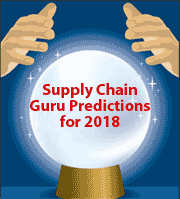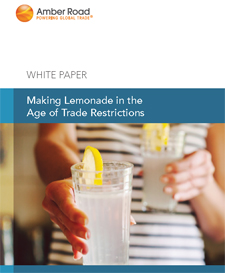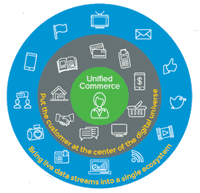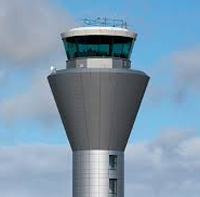The Gurus Are Back! 2018 Supply Chain Predictions
We're back as we have done for many years running with predictions for the year 2018 in supply from a virtual panel of supply chain gurus.
In fact, most of our prognosticators are back from 2017, selected again for this great honor - well, something of an honor - because in the past they have made insightful predictions and (very importantly) are able to get them emailed in before the deadline.
As I say every year, given how difficult it is to make predictions in this crazy world of supply chain, these prognostications are part prediction, part a discussion of trends, part some things to look out for - but it is all good, and I much enjoy these pieces every year. As always, I'll publish two First Thoughts columns summarizing those predictions from all our gurus, followed by full text versions of the predictions in our OnTarget soon after.
| GILMORE SAYS: |
For 2018, Regan says "The Perfect Storm has come ashore and it is going to wallop a lot of shipper freight budgets!
WHAT DO YOU SAY?
Send us your
Feedback here
|
Since the areas of supply chain analytics, machine learning, etc. are so hot right now, let's start with Dr. Michael Watson, of Northwestern University and his company OpEx Analytics, who is also an SCDigest columnist. He is one of the best there is on these topics.
I asked him to offer some thoughts on where supply chain network design and advanced analytics in supply chain were heading in 2018.
"Retailer OTIF (on-time, in full - see Watson's SCDigest article and the one that precedes it here on this topic) penalties will cause many manufacturers to invest more in analytics to prevent these penalties, Watson expects.
"This will include better network design - so you are set up to hit the OTIF; better transportation analytics - to make sure you hit the time window; and better inventory analysis -to make sure you have the stuff when you need it," Watson notes.
Among other predictions, Watson also says that "direct to customer" will continue to drive analytics and network design in 2018.
"I heard a great talk from Home Depot at CSCMP talking about their journey to deliver directly. Besides the IT work, there is a lot of network design and analytics that go into these solutions," Watson notes. "This includes deciding where to pull from, figuring out an inventory strategy, deciding the fleet size or how to outsource, and how to plan and schedule your capacity. You need to have some fast analytics running behind the scenes to make sure that you can deliver when you promise."
Watson also expects "that in 2018, almost any company that analyzes data will call it Artificial Intelligence." You have been warned.
I am glad to have back Mike Regan of TranzAct Technologies, who always has something interesting to say, usually related to freight transportation, whether it is at the NASSTRAC annual conference, his own weekly "two-minute warning" videos, or here on SCDigest, where he is a frequent contributor.
Regan should be taking a victory lap. For the past couple of years, he has been warning shippers that if the US economy ever starts to see consistent 3+% growth, transportation costs were likely to soar, due largely to the very real but somewhat obscured driver shortage in the face of what was a tepid freight environment for a couple of years.
Well, we've seen 3% growth in Q2, Q3 and likely Q4 when the numbers are released – and right on cue, rates are exploding. Truckload rates in the US were up 6.2% in both November and December, according to the Cass Linehaul Index, which itself now predicts rate increases of a hefty 6-8% in 2018.
For 2018, Regan says "The Perfect Storm has come ashore and it is going to wallop a lot of shipper freight budgets!" He adds that "This "transportation Perfect Storm" will expose transportation/supply chain operational and technological fault lines for shippers."
 He expects the impact of this Perfect Storm will hit shippers differently, depending on the spade work they have done to prepare. So, for example, there will be shippers with a demonstrated track record for having built truly collaborative relationships with their carriers over the years. He expects the impact of this Perfect Storm will hit shippers differently, depending on the spade work they have done to prepare. So, for example, there will be shippers with a demonstrated track record for having built truly collaborative relationships with their carriers over the years.
"The carriers have excellent data and know which shippers have supported them in the past, as opposed to shippers that have talked a good game but who have consistently been focused on getting the lowest possible rates." These shippers will get the capacity in a very tight market.
This group of prepared shippers will also have proactively invested in managing their transportation operations as well as implementing the necessary technology to be able to get their freight moved at a reasonable price, Regan says.
But on the other side of the fault line "will be shippers who have treated transportation as an afterthought or viewed it as a necessary evil," Regan says. "Consequently, they really don't have a strategy or the operational or technological tools to aggressively manage their freight spend. These shippers will see rate increases of at least 8-15%." Yikes!
Another of Regan's "bold predictions": These huge rate increases will result in blown freight budgets and cause more C-Level executives to pay attention to this thing called "freight."
He says one CEO recently told him, "For the first time ever, my board wants to review our transportation spend management program."
Bottom line: It is beyond time to get on top of this.
Gene Tyndall is a long term friend of mine, notable for leading E&Y's impressive supply chain consulting practice in the 1990's, and co-author of one of the best books ever in the industry ("Supercharging Supply Chains"). He has been at Tompkins International the past few years, and is now leading its MonarchFx unit, which is building out an efulfillment network.
First, Tyndall cited what he calls an obvious trend: The highly positive state of the economy will drive supply chain innovation and transformation.
However, he says, that transformation will come "more by natural events than by astute design."
A 3% GDP growth can "lift all boats," Tyndall notes, adding that when companies have positive cash flows and higher discretionary income, there is more capital to invest, and new plant and equipment rises to the top of executive agendas.
"Adoption of new technologies, coupled with ecommerce and digitalization, will generate more investments, new products and services, and new efficiencies within infrastructure, as well as new plant and equipment," Tyndall says. "This does not necessarily imply that investments will be optimized, or even well justified, only that the capital will there for reinvesting in the business. The certainty of the positive economy is outweighed by the uncertainty of the markets, the disrupters, and customer buying behavior. Thus, we will see investments (including M&A) but not necessarily the right ones."
Tyndall also notes with all the current change, from the growth of Amazon to the impact of digitization, "If all companies do not change, they will be disrupted, beaten competitively, or simply regarded as obsolete," Tyndall says.
What to do? You start with a laser focus on customers, Tyndall says, especially the needs and behaviors of millennials. Second, get on top of all the emerging technologies (drones, robotics, 3D printing, etc.), and focus on digitizing the business.
"All businesses need to adapt these technologies in innovative ways to compete, or simply stagnate," Tyndall says.
Third, focus as never before on speed. This, I will note parenthetically, is one of Amazon's main advantages – it simply moves faster than everyone else.
Interestingly Tyndall says, "Change management has always been the major barrier to change, but in 2018 it will not hold up speed," adding that "People must adapt to change and speed, or else - and they will learn this the hard way."
All good stuff. Full text of these guru predictions coming soon in our OnTarget newsletter, and summaries from another set of gurus next week.
Any reaction to the guru predictions? What resonates with you? What are some of your 2018 supply chain predictions? Let us know your thoughts at the Feedback button below. |



![]()

![]()

![]()









 He expects the impact of this Perfect Storm will hit shippers differently, depending on the spade work they have done to prepare. So, for example, there will be shippers with a demonstrated track record for having built truly collaborative relationships with their carriers over the years.
He expects the impact of this Perfect Storm will hit shippers differently, depending on the spade work they have done to prepare. So, for example, there will be shippers with a demonstrated track record for having built truly collaborative relationships with their carriers over the years.

